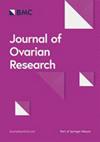Yu Linzhu alleviates primary ovarian insufficiency in a rat model by improving proliferation and energy metabolism of granulosa cells through hif1α/cx43 pathway
IF 3.8
3区 医学
Q1 REPRODUCTIVE BIOLOGY
引用次数: 0
Abstract
Yu Linzhu (YLZ) is a classical Chinese traditional formula, which has been used for more than 600 years to regulate menstruation to help pregnancy. However, the mechanism of modern scientific action of YLZ needs to be further studied. Thirty SD female rats were divided into three groups to prepare the blank serum and drug-containing serum, and then using UHPLC-QE-MS to identify the ingredients of YLZ and its drug-containing serum. Twenty-four SD female rats were divided into four groups, except the control group, 4-vinylcyclohexene dicycloxide (VCD) was intraperitoneally injected to establish a primary ovarian insufficiency (POI) model of all groups. Using vaginal smear to show that the estrous cycle of rats was disturbed after modeling, indicates that the POI model was successfully established. The ELISA test was used to measure the follicle-stimulating hormone (FSH), estradiol (E2), and anti-Mullerian hormone (AMH) levels in the serum of rats. HE stain was used to assess the morphology of ovarian tissue. The localization and relative expression levels of CX43 protein were detected by tissue immunofluorescence. Primary ovarian granulosa cells (GCs) were identified by cellular immunofluorescence. CCK8 was used to screen time and concentration of drug-containing serum and evaluate the proliferation effect of YLZ on VCD-induced GCs. ATP kit and Seahorse XFe24 were used to detect energy production and real-time glycolytic metabolism rate of GCs. mRNA and protein expression levels of HIF1α, CX43, PEK, LDH, HK1 were detected by RT-PCR and WB. UHPLC-QE-MS found 1702 ingredients of YLZ and 80 constituents migrating to blood. YLZ reduced the FSH while increasing the AMH and E2 levels. In ovarian tissues, YLZ improved ovarian morphology, follicle development, and the relative expression of CX43. In vitro studies, we found that YLZ increased the proliferative activity of GCs, ATP levels, glycolytic metabolic rate, HIF1α, CX43, PEK, HK1, LDH mRNA, and protein levels. The study indicated that YLZ increased the proliferation and glycolytic energy metabolism of GCs to improve follicular development further alleviating ovarian function.玉灵珠通过 hif1α/cx43 通路改善颗粒细胞的增殖和能量代谢,缓解大鼠原发性卵巢功能不全模型的症状
玉灵珠(YLZ)是一种经典的中国传统配方,用于调经助孕已有 600 多年的历史。然而,YLZ 的现代科学作用机制有待进一步研究。将30只SD雌性大鼠分为三组,分别制备空白血清和含药血清,然后采用超高效液相色谱-质谱联用仪(UHPLC-QE-MS)鉴定YLZ及其含药血清的成分。将24只SD雌性大鼠分为4组,除对照组外,各组均腹腔注射4-乙烯基环己烯二环氧化物(VCD)建立原发性卵巢功能不全(POI)模型。用阴道涂片显示建模后大鼠的发情周期受到干扰,表明 POI 模型建立成功。用酶联免疫吸附试验检测大鼠血清中的促卵泡激素(FSH)、雌二醇(E2)和抗穆勒氏管激素(AMH)水平。HE 染色用于评估卵巢组织的形态。组织免疫荧光法检测 CX43 蛋白的定位和相对表达水平。通过细胞免疫荧光鉴定原发性卵巢颗粒细胞(GCs)。用CCK8筛选含药血清的时间和浓度,并评估YLZ对VCD诱导的GCs的增殖效应。通过 RT-PCR 和 WB 检测 HIF1α、CX43、PEK、LDH、HK1 的 mRNA 和蛋白表达水平。超高效液相色谱-质谱联用仪(UHPLC-QE-MS)发现,YLZ含有1702种成分,80种成分可迁移到血液中。YLZ可降低FSH,同时提高AMH和E2水平。在卵巢组织中,YLZ可改善卵巢形态、卵泡发育和CX43的相对表达。在体外研究中,我们发现 YLZ 提高了 GCs 的增殖活性、ATP 水平、糖酵解代谢率、HIF1α、CX43、PEK、HK1、LDH mRNA 和蛋白水平。研究表明,YLZ 可增加 GCs 的增殖和糖酵解能量代谢,从而改善卵泡发育,进一步缓解卵巢功能。
本文章由计算机程序翻译,如有差异,请以英文原文为准。
求助全文
约1分钟内获得全文
求助全文
来源期刊

Journal of Ovarian Research
REPRODUCTIVE BIOLOGY-
CiteScore
6.20
自引率
2.50%
发文量
125
审稿时长
>12 weeks
期刊介绍:
Journal of Ovarian Research is an open access, peer reviewed, online journal that aims to provide a forum for high-quality basic and clinical research on ovarian function, abnormalities, and cancer. The journal focuses on research that provides new insights into ovarian functions as well as prevention and treatment of diseases afflicting the organ.
Topical areas include, but are not restricted to:
Ovary development, hormone secretion and regulation
Follicle growth and ovulation
Infertility and Polycystic ovarian syndrome
Regulation of pituitary and other biological functions by ovarian hormones
Ovarian cancer, its prevention, diagnosis and treatment
Drug development and screening
Role of stem cells in ovary development and function.
 求助内容:
求助内容: 应助结果提醒方式:
应助结果提醒方式:


